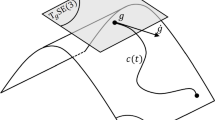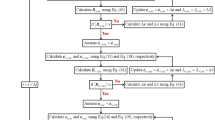Abstract
Optimal rigid body angular motions are investigated in the absence of direct control over one of the angular velocity components, via an approximate dynamic model. An analysis of first-order necessary conditions for optimality with the proposed model reveals that, over a large range of boundary conditions, there are, in general, several distinct extremal solutions. A classification in terms of subfamilies of extremal solutions is presented. Second-order necessary conditions are investigated to establish local optimality for the candidate minimizers.
Similar content being viewed by others
References
Athans, M., andFalb, P. L.,Optimal Control, McGraw-Hill, New York, New York, 1966.
Lee, E. B., andMarcus, L.,Foundations of Optimal Control Theory, John Wiley and Sons, New York, New York, 1967.
Debs, A. S., andAthans, M.,On the Optimal Angular Velocity Control of Asymmetric Space Vehicles, IEEE Transactions on Automatic Control, Vol. AC-14, pp. 80–83, 1969.
Dwyer, T.,The Control of Angular Momentum for Asymmetric Rigid Bodies, IEEE Transactions on Automatic Control, Vol. AC-27, pp. 686–686, 1982.
Golubev, Iu. V., andDemidov, V. N.,An Optimal Control Law for Stopping Rotation, Akademiia Nauk SSSR, Izvestiia, Mekhanika Tverdogo Tela, pp. 18–24, 1984.
Junkins, J. L., andTurner, J. D.,Optimal Continuous Torque Attitude Maneuvers, Journal of Guidance, Control, and Dynamics, Vol. 3, pp. 210–217, 1980.
Carrington, C. K., andJunkins, J. L.,Nonlinear Feedback Control of Spacecraft Slew Maneuvers, Paper No. AAS-83-002, AAS Rocky Mountain Guidance and Control Conference, Keystone, Colorado, 1982.
Li, F., andBainum, P. M.,Minimum-Time Attitude Slewing Maneuvers of a Rigid Spacecraft, AIAA Paper No. 88-0675, AIAA 26th Aerospace Sciences Meeting, Reno, Nevada, 1988.
Mereau, P., andPowers, W. F.,The Darboux Point, Journal of Optimization Theory and Applications, Vol. 17, pp. 545–559, 1975.
Breakwell, J. V., andHo, Y. C.,On the Conjugate Point Condition for the Control Problem, International Journal of Engineering Science, Vol. 2, pp. 565–579, 1964.
Moyer, H. G.,Optimal Control Problems That Test for Envelope Contacts, Journal of Optimization Theory and Applications, Vol. 6, pp. 287–298, 1970.
Kelley, H. J., andMoyer, H. G.,Computational Jacobi-Test Procedure, JUR-EMA Workshop on Current Trends in Control, Dubrovnik, Yugoslavia, 1984.
Jacobson, D. H.,Sufficient Conditions for Nonnegativity of the Second Variation in Singular and Nonsingular Control Problems, SIAM Journal on Control, Vol. 8, pp. 403–423, 1970.
Author information
Authors and Affiliations
Additional information
Communicated by D. G. Hull
This work was supported in part by DARPA Contract No. ACMP-F49620-87-C-0116 and by Air Force Grant AFOSR-89-0001.
Rights and permissions
About this article
Cite this article
Chowdhry, R.S., Ben-Asher, J.Z. & Cliff, E.M. Optimal rigid body motions, part 1: Approximate formulation. J Optim Theory Appl 70, 57–78 (1991). https://doi.org/10.1007/BF00940504
Issue Date:
DOI: https://doi.org/10.1007/BF00940504




